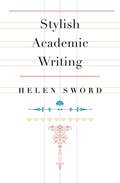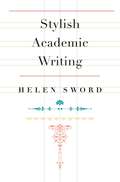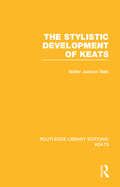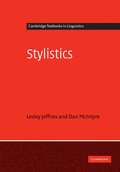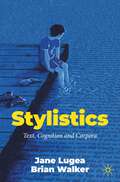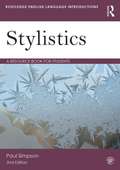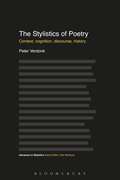- Table View
- List View
Stylish Academic Writing
by Helen SwordElegant ideas deserve elegant expression. Sword dispels the myth that you can’t get published without writing wordy, impersonal prose. For scholars frustrated with disciplinary conventions or eager to write for a larger audience, here are imaginative, practical, witty pointers that show how to make articles and books enjoyable to read—and to write.
Stylish Academic Writing
by Helen SwordElegant ideas deserve elegant expression. Sword dispels the myth that you can’t get published without writing wordy, impersonal prose. For scholars frustrated with disciplinary conventions or eager to write for a larger audience, here are imaginative, practical, witty pointers that show how to make articles and books enjoyable to read—and to write.
Stylistic Approaches to Nigerian Fiction
by D. TuncaDrawing on the discipline of stylistics, this book introduces a series of methodological tools and applies them to works by well-known Nigerian writers, including Abani, Adichie and Okri. In doing so, it demonstrates how attention to form fosters understanding of content in their work, as well as in African and postcolonial literatures more widely.
Stylistic Approaches to Pop Culture (Routledge Studies in Rhetoric and Stylistics)
by Christoph SchubertThis collection showcases the unique potential of stylistic approaches for better understanding the multifaceted nature of pop culture discourse. As its point of departure, the book takes the notion of pop culture as a phenomenon characterized by the interaction of linguistic signs with other modes such as imagery and music to examine a diverse range of genres through the lens of stylistics. Each section is grouped around thematic lines, looking at literary fiction, telecinematic discourse, music and lyrics, as well as cartoons and video games. The 12 chapters analyze different forms of media through five central strands of stylistics, from sociolinguistic, pragmatic, cognitive, multimodal, to corpus-based approaches. In drawing on these various stylistic frameworks and applying them across genres and modes, the contributions offer readers deeper insights into the role of scripted and performed language in social representation and identity construction, thereby highlighting the affordances of stylistics research in studying pop cultural texts. This volume is of particular interest to students and researchers in stylistics, linguistics, literary studies, media studies, and cultural studies.
Stylistic Approaches to Pop Culture (Routledge Studies in Rhetoric and Stylistics)
by Christoph Schubert Valentin WernerThis collection showcases the unique potential of stylistic approaches for better understanding the multifaceted nature of pop culture discourse. As its point of departure, the book takes the notion of pop culture as a phenomenon characterized by the interaction of linguistic signs with other modes such as imagery and music to examine a diverse range of genres through the lens of stylistics. Each section is grouped around thematic lines, looking at literary fiction, telecinematic discourse, music and lyrics, as well as cartoons and video games. The 12 chapters analyze different forms of media through five central strands of stylistics, from sociolinguistic, pragmatic, cognitive, multimodal, to corpus-based approaches. In drawing on these various stylistic frameworks and applying them across genres and modes, the contributions offer readers deeper insights into the role of scripted and performed language in social representation and identity construction, thereby highlighting the affordances of stylistics research in studying pop cultural texts. This volume is of particular interest to students and researchers in stylistics, linguistics, literary studies, media studies, and cultural studies.
Stylistic Approaches to Translation (Translation Theories Explored)
by Jean Boase-BeierThe concept of style is central to our understanding and construction of texts. But how do translators take style into account in reading the source text and in creating a target text? This book attempts to bring some coherence to a highly interdisciplinary area of translation studies, situating different views and approaches to style within general trends in linguistics and literary criticism and assessing their place in translation studies itself. Some of the issues addressed are the link between style and meaning, the interpretation of stylistic clues in the text, the difference between literary and non-literary texts, and more practical questions about the recreation of stylistic effects. These various trends, approaches and issues are brought together in a consideration of the most recent cognitive views of style, which see it as essentially a reflection of mind. Underlying the book is the notion that knowledge of theory can affect the way we translate. Far from being prescriptive, theories which describe what we know in a general sense can become part of what an individual translator knows, thus opening the way for greater awareness and also greater creativity in the act of translation. Throughout the discussion, the book considers how insights into the nature and importance of style might affect the actual translation of literary and non-literary texts.
Stylistic Approaches to Translation (Translation Theories Explored #Vol. 10)
by Jean Boase-BeierThe concept of style is central to our understanding and construction of texts. But how do translators take style into account in reading the source text and in creating a target text? This book attempts to bring some coherence to a highly interdisciplinary area of translation studies, situating different views and approaches to style within general trends in linguistics and literary criticism and assessing their place in translation studies itself. Some of the issues addressed are the link between style and meaning, the interpretation of stylistic clues in the text, the difference between literary and non-literary texts, and more practical questions about the recreation of stylistic effects. These various trends, approaches and issues are brought together in a consideration of the most recent cognitive views of style, which see it as essentially a reflection of mind. Underlying the book is the notion that knowledge of theory can affect the way we translate. Far from being prescriptive, theories which describe what we know in a general sense can become part of what an individual translator knows, thus opening the way for greater awareness and also greater creativity in the act of translation. Throughout the discussion, the book considers how insights into the nature and importance of style might affect the actual translation of literary and non-literary texts.
The Stylistic Development of Keats (Routledge Library Editions: Keats)
by Walter Jackson BateThis study, first published in 1945, gives a precise description of the unfolding of a great poet’s craftsmanship and suggests alignments of the technical progression with the changes of the mind. Metrical analysis is given in order to throw light on Keats’ general stylistic development using the simplest terminology and in a traditional manner. Earlier English prosodic writings are referred to throughout in order to place the style and development in the context of the period. Arranged chronologically, each chapter looks at a particular work or group of works drawing together evidence about Keats’ poetic direction. This classic work from a well-known Keats scholar is an important enlightening contribution within the extensive study of Keats’ poetry and letters.
The Stylistic Development of Keats (Routledge Library Editions: Keats)
by Walter Jackson BateThis study, first published in 1945, gives a precise description of the unfolding of a great poet’s craftsmanship and suggests alignments of the technical progression with the changes of the mind. Metrical analysis is given in order to throw light on Keats’ general stylistic development using the simplest terminology and in a traditional manner. Earlier English prosodic writings are referred to throughout in order to place the style and development in the context of the period. Arranged chronologically, each chapter looks at a particular work or group of works drawing together evidence about Keats’ poetic direction. This classic work from a well-known Keats scholar is an important enlightening contribution within the extensive study of Keats’ poetry and letters.
Stylistics: A Practical Coursebook
by Jonathan Hope Laura WrightUsing a wide range of twentieth-century literary prose Laura Wright and Jonathan Hope provide an `interactive' introduction to the techniques of stylistic analysis. Divided up into five sections; the noun phrase, the verb phrase, the clause, text structure and vocabulary, the book also provides an introduction to the basics of descriptive grammar for beginning students. * Presumes no prior linguistic knowledge * Provides a comprehensive glossary of terms * Adaptable: designed to be used in a variety of classroom contexts * Introduces students to an enormous range of 20th century literature from James Joyce to Roddy Doyle A practical coursebook rather than a survey account of stylistics as a discipline, the book provides over forty opportunities for hands-on stylistic analysis. For each linguistic feature under discussion the reader is offered a definition, a text for analysis, exercises and tasks, in addition to a suggested solution. Stylistics: A Practical Coursebook is genuinely `student friendly' and will be an invaluable tool for all beginning undergraduates and A-level students of language and literature.
Stylistics: A Practical Coursebook
by Jonathan Hope Laura WrightUsing a wide range of twentieth-century literary prose Laura Wright and Jonathan Hope provide an `interactive' introduction to the techniques of stylistic analysis. Divided up into five sections; the noun phrase, the verb phrase, the clause, text structure and vocabulary, the book also provides an introduction to the basics of descriptive grammar for beginning students. * Presumes no prior linguistic knowledge * Provides a comprehensive glossary of terms * Adaptable: designed to be used in a variety of classroom contexts * Introduces students to an enormous range of 20th century literature from James Joyce to Roddy Doyle A practical coursebook rather than a survey account of stylistics as a discipline, the book provides over forty opportunities for hands-on stylistic analysis. For each linguistic feature under discussion the reader is offered a definition, a text for analysis, exercises and tasks, in addition to a suggested solution. Stylistics: A Practical Coursebook is genuinely `student friendly' and will be an invaluable tool for all beginning undergraduates and A-level students of language and literature.
Stylistics (Cambridge Textbooks In Linguistics Ser. (PDF))
by Lesley Jeffries Daniel McIntyreStylistics is the linguistic study of style in language. It aims to account for how texts project meaning, how readers construct meaning and why readers respond to texts in the way that they do. This book is an introduction to stylistics that locates it firmly within the traditions of linguistics. Organised to reflect the historical development of stylistics from its origins in Russian formalism, the book covers key principles such as foregrounding theory, as well as more recent developments in cognitive stylistics. It includes an examination of both literary and non-literary texts, and substantial coverage of methodologies for stylistic analysis. Throughout the book, the emphasis is on the practicalities of producing stylistic analyses that are objective, replicable and falsifiable. Comprehensive in its coverage and assuming no prior knowledge of the topic, Stylistics will be essential reading for undergraduate and graduate students new to this fascinating area of language study.
Stylistics: Text, Cognition and Corpora
by Jane Lugea Brian WalkerThis textbook introduces the reader to contemporary approaches to language analysis such as cognitive stylistics and corpus stylistics, reflecting recent shifts in research trends and offering students a practical way to access and understand these developments. The authors lead readers through detailed explanations, guided analyses, examples of research and suggestions for further reading. This textbook makes an ideal introduction to the field of stylistics for students who are new to the area, but who have some background in basic language analysis. It will be of use to students on courses in stylistics, literary linguistics, corpus methods, cognitive linguistics, and language and style.
Stylistics: A Resource Book For Students (Routledge English Language Introductions Ser. (PDF))
by Paul SimpsonAssuming no prior knowledge, books in the series offer an accessible overview of the subject, with activities, study questions, sample analyses, commentaries and key readings – all in the same volume. The innovative and flexible ‘two-dimensional’ structure is built around four sections – introduction, development, exploration and extension – which offer self-contained stages for study. Each topic can be read across these sections, enabling the reader to build gradually on the knowledge gained. Written in a clear and accessible style, Stylistics, Second Edition is a comprehensive resource which covers all the major theories, concepts and methods required for the investigation of language in literature. From metre to metaphor, dialogue to discourse, the main topics are introduced and fully elaborated, as are the key research paradigms of this important and exciting field of study. Stylistics is richly illustrated with many examples from literary texts, including writing from the established literary canon alongside more contemporary work in poetry, prose and drama. Each of the book’s twelve chapters contains clearly framed suggestions for practical work and is accompanied by an original reading on the relevant topic by a world-renowned scholar. This exciting new second edition builds on the strengths of the first by adding many fresh exercises and worked examples. It captures the latest major developments in stylistics, such as corpus, cognitive and multimodal approaches to the study of style, and its accompanying website has also been substantially revised to feature, amongst other things, useful links, worked examples and a new web strand on style and humour. In addition to the classic readings in stylistics contained in the first edition, the new edition includes a number of recent, stimulating readings by key figures in the contemporary field. Written by an experienced teacher and researcher, this accessible textbook is an essential resource for all students of English language, linguistics and literature.
Stylistics: A Resource Book For Students (Routledge English Language Introductions Ser.)
by Paul SimpsonAssuming no prior knowledge, books in the Routledge English Language Introductions series offer an accessible overview of the subject, with activities, study questions, sample analyses, commentaries and key readings – all in the same volume. The innovative and flexible 'two-dimensional' structure is built around four sections – introductions, development, exploration and extension – which offer self-contained stages for study. Each topic can also be read across these sections, enabling the reader to build gradually on the knowledge gained. Stylistics: * is a comprehensive introduction to literary stylistics * covers the core areas, including register, dialect, vocabulary, grammar, sound and rhythm, speech and thought, narrative, dialogue, metaphor and meaning * draws on a range of literary texts, from Ernest Hemingway and D.H. Lawrence to Sylvia Plath, Roger McGough and Irvine Welsh * provides classic readings by the key names in the discipline, including Derek Attridge, Ronald Carter and Walter Nash, Roger Fowler and Mick Short. The accompanying webiste to this book can be found at http://www.routledge.com/textbooks/0415281059
Stylistics and Psychology: Investigations of Foregrounding (Routledge Revivals)
by Willie Van PeerFirst published in 1986, Stylistics and Psychology is an empirical investigation into foregrounding. The theory of foregrounding has received little in the way of empirical testing within the field of stylistics and literary criticism. The book engages extensively with the author’s own research involving psychological testing and provides a rigorous, scientific approach to stylistics. It presents evidence of a general link between foregrounding and evaluation, apparent in correlations between foregrounding and evaluation, between foregrounding and reader preference, and between foregrounding and readers’ evaluative associations. Stylistics and Psychology will appeal to those with an interest in literary criticism and linguistics.
Stylistics and Psychology: Investigations of Foregrounding (Routledge Revivals)
by Willie Van PeerFirst published in 1986, Stylistics and Psychology is an empirical investigation into foregrounding. The theory of foregrounding has received little in the way of empirical testing within the field of stylistics and literary criticism. The book engages extensively with the author’s own research involving psychological testing and provides a rigorous, scientific approach to stylistics. It presents evidence of a general link between foregrounding and evaluation, apparent in correlations between foregrounding and evaluation, between foregrounding and reader preference, and between foregrounding and readers’ evaluative associations. Stylistics and Psychology will appeal to those with an interest in literary criticism and linguistics.
Stylistics and Shakespeare's Language: Transdisciplinary Approaches (Advances in Stylistics)
by Mireille Ravassat Jonathan CulpeperThis innovative volume testifies to the current revived interest in Shakespeare's language and style and opens up new and captivating vistas of investigation. Transcending old boundaries between literary and linguistic studies, this engaging collaborative book comes up with an original array of theoretical approaches and new findings. The chapters in the collection capture a rich diversity of points of view and cover such fields as lexicography, versification, dramaturgy, rhetorical analyses, cognitive and computational corpus-based stylistic studies, offering a holistic vision of Shakespeare's uses of language. The perspective is deliberately broad, confronting ideas and visions at the intersection of various techniques of textual investigation. Such novel explorations of Shakespeare's multifarious artistry and amazing inventiveness in his use of language will cater for a broad range of readers, from undergraduates, postgraduates, scholars and researchers, to poetry and theatre lovers alike.
Stylistics and Shakespeare's Language: Transdisciplinary Approaches (Advances in Stylistics)
by Mireille Ravassat Jonathan CulpeperThis innovative volume testifies to the current revived interest in Shakespeare's language and style and opens up new and captivating vistas of investigation. Transcending old boundaries between literary and linguistic studies, this engaging collaborative book comes up with an original array of theoretical approaches and new findings. The chapters in the collection capture a rich diversity of points of view and cover such fields as lexicography, versification, dramaturgy, rhetorical analyses, cognitive and computational corpus-based stylistic studies, offering a holistic vision of Shakespeare's uses of language. The perspective is deliberately broad, confronting ideas and visions at the intersection of various techniques of textual investigation. Such novel explorations of Shakespeare's multifarious artistry and amazing inventiveness in his use of language will cater for a broad range of readers, from undergraduates, postgraduates, scholars and researchers, to poetry and theatre lovers alike.
Stylistics and the Teaching of Literature
by H. G. WiddowsonFirst published in 1976. Routledge is an imprint of Taylor & Francis, an informa company.
Stylistics and the Teaching of Literature
by H. G. WiddowsonFirst published in 1976. Routledge is an imprint of Taylor & Francis, an informa company.
The Stylistics of Poetry: Context, cognition, discourse, history (Advances in Stylistics)
by Peter VerdonkWritten over the last thirty years, this collection of Professor Peter Verdonk's most important work on the stylistics of poetry clearly shows that the stylistics of poetic discourse is a diverse and valuable interdiscipline. Discussing the poetry of Auden, Heaney and Larkin amongst many others, Verdonk covers everything from intrinsic textual meaning and external context in its widest sense to the reader's cognitive and emotive response to poems. The book will appeal to all students on stylistics and literary linguistics courses, especially those focussing on poetry and poetic language.
The Stylistics of Poetry: Context, cognition, discourse, history (Advances in Stylistics)
by Peter VerdonkWritten over the last thirty years, this collection of Professor Peter Verdonk's most important work on the stylistics of poetry clearly shows that the stylistics of poetic discourse is a diverse and valuable interdiscipline. Discussing the poetry of Auden, Heaney and Larkin amongst many others, Verdonk covers everything from intrinsic textual meaning and external context in its widest sense to the reader's cognitive and emotive response to poems. The book will appeal to all students on stylistics and literary linguistics courses, especially those focussing on poetry and poetic language.
The Stylistics of Professional Discourse
by Martin SollyWhy are doctors’ prescriptions illegible and why is the language of the law considered impenetrable to outsiders? Need they be so? Is it more difficult for non-native speakers of English than native speakers to access the discourse of professions such as law and medicine? These are some of the questions covered by this book which uses the lens of stylistics to shed light on how the discourse of professional communities is used not just to convey meanings, but also to construct identity and demark membership. The volume focuses on the three domains of healthcare, law and education, as well as on the language of the new technologies, with the aim of showing how a knowledge of stylistics can provide the key for appropriate and acceptable language use, enabling successful communication and potential membership of professional communities.
Stylistics (PDF)
by Lesley Jeffries Daniel McintyreStylistics is the linguistic study of style in language. It aims to account for how texts project meaning, how readers construct meaning and why readers respond to texts in the way that they do. This book is an introduction to stylistics that locates it firmly within the traditions of linguistics. Organised to reflect the historical development of stylistics from its origins in Russian formalism, the book covers key principles such as foregrounding theory, as well as more recent developments in cognitive stylistics. It includes an examination of both literary and non-literary texts, and substantial coverage of methodologies for stylistic analysis. Throughout the book, the emphasis is on the practicalities of producing stylistic analyses that are objective, replicable and falsifiable. Comprehensive in its coverage and assuming no prior knowledge of the topic, Stylistics will be essential reading for undergraduate and graduate students new to this fascinating area of language study.
